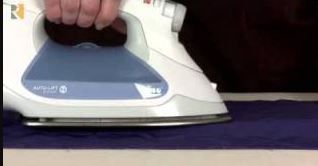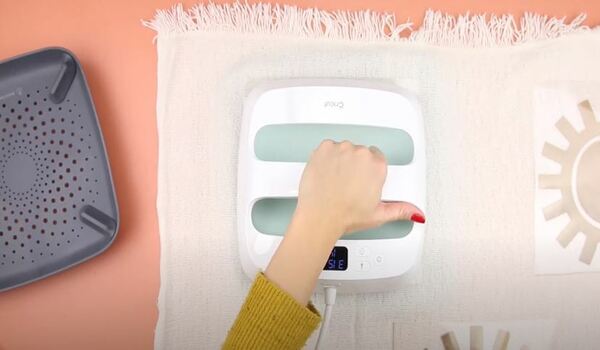Can you heat press velvet? Method, Tips, and FAQs
Velvet is a type of textile with a pile or nap. It is typically a heavy fabric with a short, plush pile on one side, used for upholstery or to cover furniture. The pile of velvet is usually made of spun cotton, wool, or silk. It is usually woven on a diagonal loom so that one end of the fabric is wider than the other.
Velvet is popular because it has a luxurious feel and drape due to the velvet pile.
Can you heat press velvet fabric?
Yes, you can heat press velvet. However, do not use a heat press machine. Instead, use a household iron. A heat press machine will destroy the velvet fabric because of high heat and pressure. There is a misconception that you can’t use HTV on velvet because the heat will destroy the fabric. However, I did some experiments, and guess what? The results showed that HTV transfers onto ironed velvet just fine.
What to do before heat pressing velvet?
- Velvet should have a thin and short pile. That way, it will be less likely to show any wear and tear after being ironed.
- Do use velvet with spandex, starch, and velour as it will stretch too much and lose any pattern or design.
- I would recommend practicing on your own first and reading all of the instructions that come with HTV.
How to heat press velvet?
- You will need a good household iron, t-shirt vinyl, ironing board, Teflon paper, weeding tools, cutter, and velvet sample.
- Turn on the iron. Check to see if it is heated up and preheat it to approximately 300 degrees. Keep heat levels as low as possible. This will make sure we don’t ruin the fabric.
- When the iron is hot, preheat your fabric. This will dry any moisture on it, which can prevent your adhesive from working properly. Hold the iron near the fabric for around ten seconds to do this and then you can finally begin with your pressing project.
- Place your decal onto the project you are working with and then starting with one area at a time, start ironing it in. Iron for 10 seconds without adding any Teflon sheet into it next and after that 15 seconds by using the Teflon sheet before moving on to your next section. Use light to medium pressure.
- Wait for your project to cool down before peeling off the carrier sheet or else it might stick back on when peeled. To make sure it sticks well, wait for 10 seconds and heat your vinyl for another 7 seconds with a Teflon sheet placed in between. (This is step is optional)
- Let your work cool down for 10 more seconds and then remove the Teflon sheet. The HTV should be lined up smoothly and will stay in place much better this way.



Tips for heat pressing delicate fabrics
Do a test first
You don’t want to do too much damage to velvet. Do a test to find the right amount of force. Velvet is a delicate fabric, so be careful not to apply too much heat or pressure when ironing it, otherwise, it will become flat. You can use this chart to find the right temperature.
Don’t iron seams
Seams are delicate and this could damage them. Design your project so no parts are sticking out near any seams because the heat from an iron could damage them
Avoid heat press
The heat and pressure from a heat press are likely to crush your soft fabric and cause you more work down the line.
Avoid movement
Refrain from moving your iron while pressing down on your HTV. The HTV is sitting on a plush velvet pad and sliding it around will just lead to an uneven look.
Pros and cons of heat pressing velvet
Pros
- This process can provide an excellent finish and a strong design.
- It is a cost-effective way to make custom velvet fabric products.
- The design will stay in the same place and will not fade.
Cons
- The most obvious disadvantage of heat pressing vinyl onto velvet is that the process might discolor the fabric.
- Velvet fabric is delicate and can be easily damaged if not cared for properly.
- It requires extreme attention.
FAQs
Does velvet melt in the heat?
Rayon velvet can easily melt when the iron is applied to the wrong side, so it’s important to know where to place the iron and not accidentally stick it in the middle of your fabric while you’re pressing. Acetate and other chenille fabrics are more delicate too and should be handled with care by avoiding heat presses when they’re wet.
How do you emboss on velvet?
You can emboss custom designs on velvet using a hot iron and a craft heat embossing tool.
What are the types of velvet?
There are many types of velvet, including:
- Taffeta velvet
- Chenille velvet
- Frosted velvet
- Crushed velvet
- Glazed velvet
- Embossed velvet
- Silk velvet
- Cotton velvet
How to iron velvet seams?
If you want to avoid flattening the raised fibers of velvet while ironing its seams, use a steam iron set at medium heat and hold it half an inch away from the fabric. Once the ironing is done, carefully press open the seam with your fingers. Protect your fingers by wearing guards to minimize burns.
To reduce the appearance of seam marks on a piece of clothing while ironing, a seam roll can be utilized. If these marks are still noticeable on the front side of the fabric, they can be removed by applying gentle steam to the right side using a garment steamer or iron.
When ironing velvet, use only the small toe of the iron to touch the seams, even if your fabric can handle heat and coming into contact with the iron.
Can I iron velvet?
Yes, you can iron velvet. Make sure to use the iron at the lowest possible settings. Otherwise, it will damage the fabric. Alternatively, you can use a clothes streamer. It is the best option to iron the velvet.
Can you heat press with an iron?
Yes, you can heat press with an iron. However, you will not have much control over the pressure and temperature settings. Make sure the iron has no holes on the plate. Here is how you can convert your iron to heat press.
Can you sublimate on velvet? How to do it?
Yes, you can sublimate on velvet. Here is how to sublimate on velvet:
- Preheat your heat press to 385 degrees Fahrenheit, which is a medium to heavy pressure suitable for sublimating velvet.
- Lint roll the velvet fabric to remove any debris or loose fibers that may interfere with the sublimation process.
- Prepare your design on sublimation paper and position it on the velvet fabric in the right spot without allowing it to bleed through.
- Place the velvet fabric and the sublimation paper inside the heat press.
- Apply medium to heavy pressure for 35 seconds with the heat press at 385 degrees Fahrenheit.
- After 35 seconds, remove the fabric and paper from the heat press and peel off the paper to reveal the transferred design.
- Enjoy your sublimated velvet product.
Remember to pre-press the velvet fabric for 10 seconds before sublimating, and avoid taping the velvet material as it does not adhere well to it. You may measure the fabric and paper to ensure proper placement of the design.
If you are looking for a good heat press for your business, you can use these auto-open heat press machines.

I’ve been in the printing business for 25 years. I love to share my experiences and knowledge.

